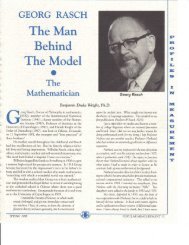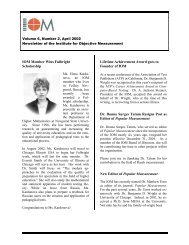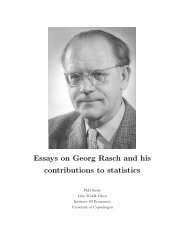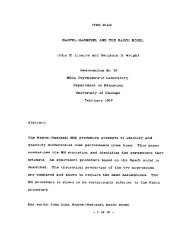Memo # 1964-2 PDF - Verio
Memo # 1964-2 PDF - Verio
Memo # 1964-2 PDF - Verio
Create successful ePaper yourself
Turn your PDF publications into a flip-book with our unique Google optimized e-Paper software.
- 15<br />
-<br />
all the probabilities to be added are equal, viz. - according to<br />
(6.4) -<br />
06.5)<br />
n<br />
v 1.11 1)<br />
s i<br />
TM v ),(E i ))<br />
Thus we just have to count the number of different ways in which<br />
it is algebraically possible to build up a zero - one - matrix with<br />
the row totals of ry ,V=1,...,n and the column totals of s i , i=1,...,k.<br />
Determining this number is a combinatorial problem and it appears<br />
to be rather difficult, but at present we need nothing more than<br />
a notation. For this number we shall write<br />
(6.6)<br />
r<br />
1" n<br />
r<br />
s<br />
1" k<br />
s<br />
and then we have<br />
(6.7) p f(a, ..r, ), (a . i .s i ) I ) , (ci#<br />
n rj, k<br />
(r,) 11 E A i<br />
(S i )<br />
(&, 1,),(E i ))<br />
This joint probability distribution of the row totals ay. and the<br />
column totals a contains just as many parameters as observables,<br />
and the latter would therefore seem suitable for estimation purposes.<br />
How true this is becomes clear when we divide (6.7) into (6.4)(or<br />
(6.5)) to obtain the probability of the whole set of observations,<br />
on the condition that the totals of rows and columns are given. In<br />
fact, all parametric terms cancel so we are left with a conditional<br />
probability<br />
(6.8) pf((a pi ))1(a p. =rv ),(a .i =s i )) -<br />
that is independent of all of the parameters.<br />
Therefore, once the totals have been recorded any further statement<br />
as regards which of the items were answered correctly by which persons<br />
is, according to our model, useless as a source of information about<br />
theparameters.(whichotherusemaybemadeofthea vi<br />
's will<br />
emerge at a later stage of our discussion). Thus the row totals<br />
and the column totals are not only suitable for estimating the<br />
parameters, they simply imply every possible statement about the<br />
Parameters that can be made on the basis of the observations ((a 1A )).<br />
Accordingly we shall, in continuation of the terminology introduced<br />
in sect. 5, characterize the row totals a y. , v.1,...n and the column<br />
totals a i , as a set of sufficient estimators for the<br />
parameters<br />
and ci,...ek.<br />
(si )









